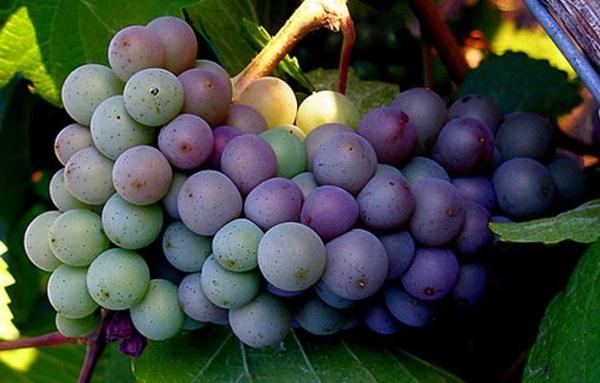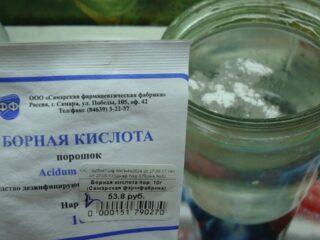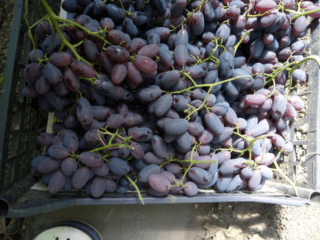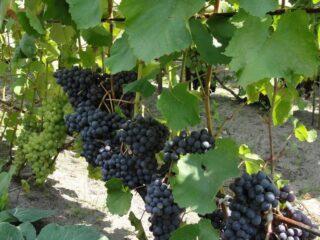Content
Many Russian gardeners grow grapes on their plots. When choosing a variety, you need to take into account the characteristics of the use of berries. To get a harvest of juicy grape bunches, you need to choose the right variety. You can plant Pinot Grigio grapes on the plot (French: Pinot Gris or Italian: Pinot Grigio). The berries of this variety produce aromatic white wine, which, according to connoisseurs, is the most delicious in the world.

In France, Italy and America, the Pinot Gris grape variety is especially popular
History of origin
Pinot Grigio grapes are a technical variety that is grown specifically for making wine. The vine was first planted in France in the 16th century; it was used to make a delicious invigorating drink for Emperor Charles IV. Then they began to grow grapes in Hungary, Germany, Italy and America.
The Pinot Grigio variety came to the Soviet Union in the second half of the 20th century. But first the breeders P. worked with him.P. Blagonravovy, E. B. Ivanov and P. V. Gorobets. Thanks to their research, productivity increased.
Description of the Pinot Grigio grape variety
Pinot Grigio grape is a Western European late variety. The name is translated from French as “gray cone”. The vine has a developed and powerful root system, which is why it is quite tall. Young shoots are drooping and have many shortened internodes. The deep green leaves are medium-sized with three or five deeply lobed lobes.
Bunches
Pinot Gris grapes can be identified by their unusually shaped clusters. It is in the form of a cylindrical cone or just a cylinder. The berries in the bunch are arranged quite tightly, so much so that the grapes inside are deformed. The stem on which the bunch is attached is short but strong and can withstand a weight of 80-150 g.
The honey aroma of the berries attracts insects and birds. To protect the harvest, they stretch a metal mesh or hide the bunches in special bags.

If you look from the outside, it seems that the Pinot Grigio grapes have grown big buds
Berries
The Pinot Gris grape variety gets its name from the color of its berries. The delicate skin is pinkish-gray. The pulp, unlike the skin, is completely colorless, it is not even visible. The juice from which white wine is obtained will also be colorless. Acids in fruits are approximately 4.5-7 g/dm³. Sugars are contained up to – 250 g/dm³.
The berries are small in size, their diameter is 7-15 mm. Most often, the grapes of the variety are round, but, as already noted, due to the density of the bunches they can become deformed.

In recent years, clones of Pinot Gris grapes with pinkish-yellow berries have appeared
Vine
Young one-year-old shoots have a light brown tint. Then the tone acquires pink splashes.
Characteristics of Pinot Grigio grapes
When choosing a variety, winegrowers pay attention not only to the external description of the vine, but also to the characteristics. It is important to know when the berries ripen, what the yield is, whether they can be grown in a particular area and other parameters.
Ripening period
From the beginning of flowering to harvest, the harvest takes about 130-150 days, since the Pinot Gris grape variety has medium ripening periods. This parameter depends on weather conditions.
Productivity
Pinot Grigio grapes are a medium-yielding variety. On each bush, as a rule, 50% of the shoots bear fruit. The variety is grown not only in summer cottages, but also on an industrial scale for wine production. From 1 hectare up to 9 tons of aromatic berries are collected. But winegrowers do not refuse the variety, despite the fact that the yield is low, but the wine turns out to be excellent.
Taste qualities
The taste of Pinot Grigio contains delicate fruity notes. They also remain in white wine.
Where do Pinot Grigio grapes grow?
The most successful grapes are grown in the North Caucasus, Crimea, and Krasnodar Territory. In other regions, the vine may die due to spring frosts. And the winter cold (where the temperature is below -20 ° C) does not tolerate Pinot Grigio grapes well, even with good shelter.
Frost resistance
If in regions the mercury drops to -20 ° C, the Pinot Grigio vine needs to be covered. To do this, trenches are dug into which the grapes are placed. Before this, sanitary pruning is carried out, not only damaged shoots are removed, but also dry leaves.Then they carry out preventive treatment of the vine against diseases and pests. Covering material is thrown over the prepared bushes and sprinkled with earth on top.
Drought resistance
Pinot Grigio vines can withstand short periods of drought. But it should be understood that this reduces the yield of grapes and worsens the taste of the berries.
Resistance to diseases and pests
Pinot Grigio is a very old variety. But not everything is going well with his immunity. Every year it is “attacked” not only by pests, but also by diseases.

Berries and leaves are usually affected by fungal diseases
To prevent mildew, oidium and other fungal diseases, the vine must be sprayed with Bordeaux mixture, iron or copper sulfate, preparations with sulfur, as well as Topaz, Chorus, Strobi. The main thing is to be in time before the berries begin to fill.
Correct agricultural techniques allow you to avoid diseases: planting, pruning, caring for grapes.
Application
Pinot Grigio grapes are rarely consumed fresh. It is usually used to prepare table and sparkling wines and champagne.
Advantages and disadvantages
Each culture has its own advantages and disadvantages. Pinot Grigio grapes are no exception
Advantages of the variety:
- bunches with tasty and aromatic berries;
- the possibility of producing wine not only in industrial conditions, but also at home;
- unpretentiousness of care;
- attractive appearance.
Cons of Pinot Grigio:
- low yield;
- low immunity, causing the crop to get sick and be attacked by pests;
- berries cannot be stored for long periods of time;
- must be covered for the winter.
Landing Features
Pinot Grigio should be planted in sunny, open areas, preferably southwest or south facing.This variety can be propagated by cuttings; it is not only effective, but also does not require special material costs.
The hole for the seedling is prepared in advance so that the soil has time to settle. The bottom is drained with pieces of brick and gravel. Then pour in soil, 5 kg of wood ash, 500 g of azofoska. Mix everything thoroughly.
Pinot Grigio seedlings should be placed in the planting hole immediately after purchase, so as not to dry out the roots. Before planting, you should trim the roots and shoots to 3-4 buds. Dip the roots in a clay mixture and plant them in a hole. Fill the hole with soil and water.

Bushes are planted at a distance of 80 cm, with row spacing of at least 1 m
Care instructions
Young bushes up to three years of age require special care. It includes:
- pruning and forming fans on bushes;
- be sure to cover bushes in regions with cold climates;
- Pinot Grigio vines need to be opened after the spring frosts have subsided;
- the soil should be loosened and weeds should be removed at the same time;
- In the spring, small roots are trimmed and soil is added under the bare trunk.
In the future, you need to regularly prune to give the crown a fan, cordon or standard shape.
Regular watering is one of the important procedures when caring for Pinot Grigio grapes: a bucket of water per bush

Experienced winegrowers recommend installing drip irrigation over rows of vines.
The grapes are fed three times during the season: during budding, flowering, and when setting berries. Organic and mineral fertilizers are used for feeding. Urea (90 g), superphosphate (60 g), and potassium sulfate (30 g) are added to the root. As for organic matter, up to 30 l/1 m² must be added to each bush.
Conclusion
The Pinot Grigio grape has been known since the 16th century. But the variety has not lost its popularity. The berries produce delicious white or pink table and sparkling wine, as well as champagne.
Reviews of Pinot Grigio grapes








